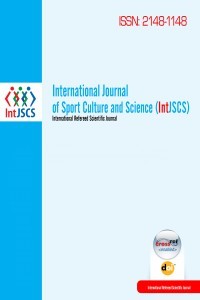Towards a New Culture in Physical Education with the Universal Design for Learning
The traditional “one-size-fits-all” approach to curriculum tends to ignore the individual
diversity in learning strengths, challenges, and interests creating barriers to learning and
inclusion in Physical Education.
The Universal design for learning (UDL), based on neuroscience research and the work of
educational psychologist Lev Vygotsky, is meaningful framework increasingly evident in
discussions of approaches to enhance educational access for all students. The purpose of this
article is to explore and analyze the Universal Design for learning (UDL) to build a didactic
plan that ensures the active participation and success in learning of all students in Physical
Education regardless of their ability.
Keywords:
Universal design for learning, inclusion physical education,
___
- Beyer R, Flores M, Vargas-Tonsing T (2009). Strategies and methods for coaching athletes with invisible disabilities in youth sport activities. The Journal of Youth Sports, 4(2): 10-15.
- Center for Applied Special Technology (2011). Universal design for learning guidelines: Full-text representation (version 2.0). Wakefield, MA: Author. P.4
- Córdoba T (2014). Inclusión en Educación Física a través de la pedagogía de la cooperación. Actas del 9° Congreso internacional de actividades fisicas cooperativas. Valladolid (Spagna):la Peonza Publicaciones.
- De Anna L (2009). Processi formativi e percorsi di integrazione nelle scienze motorie. Milano: Franco Angeli.
- Department of Education USA (2008). Higher Education Opportunity Act, Sect.103, 24, in: http://www2.ed.gov/about/bdscomm/list/naciqi.html> [Access 1/12/2016].
- Dyson B (2002). The implementation of cooperative learning in an elementary school physical education program. Journal of Teaching in Physical Education, 22(1): 69-85.
- Dyson B, Casey A (2012). Cooperative learning in Physical Education: a research based approach. London, UK: Routledge
- Dyson B, Ovens L, Smith W (2012). Implementing the cooperative learning model in physical education: the experience of the New Zealand teachers. In B. Dyson & A. Casey (Eds.), Cooperative learning in physical education .15-26: New York, NY: Routledge.
- Goodyear V (2012). Physical education teachers’ top tips for using cooperative learning to teach secondary school physical education. Physical Education Matters, 7(3): 34 – 37.
- Lieberman L, Houston-Wilson C (2002). Strategies for inclusion: A handbook for physical educators. Champaign, IL: Human Kinetics.
- Lieberman L, Lytle R, Clarcq J (2008). Getting it right from the start: Employing the universal design for learning approach to your curriculum. Journal of Physical Education, Recreation & Dance, 79(2), 32–39.
- Meyer A, Rose DH, Gordon D (2014). Universal Design for Learning: Theory and practice. Wakefield, MA: CAST Professional Publishing.
- Munafò C (2016). L’Orienteering, un’attività sportiva per l’inclusione e l’apprendimento di alunni con disabilità. Educare.it rivista on line 16(7):64-70.
- Rios M (2009). La inclusión en el area de la Educación Física en España. Análisis de las barreras para la participación y el aprendizaje. Ágora para la EF y el Deporte, n.9, pp.83-114. Valladolid: Foro para la EF.
- Rose DH (2001). Universal Design for Learning: Deriving Guiding Principles from Networks that Learn. Journal of Special Education Technology 16(1): 66-70.
- Rose DH, Meyer A (2002). Teaching every student in the digital age: Universal design for learning. Alexandria, VA: Association for Supervision and Curriculum Development (ASCD).
- Slavin RE (1996). Research on cooperative learning and achievement: What we know, what we need to know. Contemporary Educational Psychology, 21(1):43-69.
- Smith B, Markley R, Goc Karp G (1997). The effect of a cooperative learning intervention on the social skill enhancement of a third grade physical education class. Research Quarterly for Exercise and Sport, 68(Suppl.), A-68.
- Vargas-Tonsing T, Flores M, Beyer R (2008). Volunteer youth sport coaches’ efficacy beliefs for working with athletes with ADHD. Journal of Coaching Education, (1):1-16.
- Vargas T, Flores M, Beyer R (2012). Coaching athletes with hidden disabilities: Recommendations and strategies for coaching education. Strategies, 25(3):32-33.
- Wenger E (1998). Communities of practice: Learning as a social system.Systems Thinker, 9(5): 1-8.
- ISSN: 2148-1148
- Başlangıç: 2013
- Yayıncı: Uluslararası Bilim Kültür ve Spor Derneği (UBİKS)
